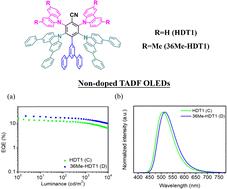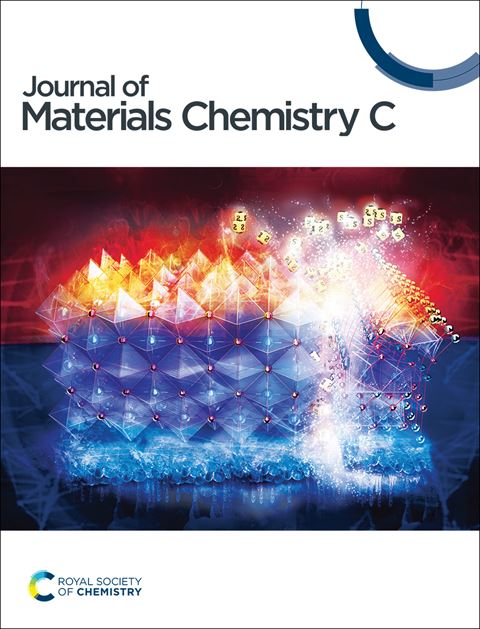高效无宿主延迟荧光有机发光二极管†
IF 5.1
2区 材料科学
Q2 MATERIALS SCIENCE, MULTIDISCIPLINARY
引用次数: 0
摘要
采用HDT1和36Me-HDT1两个热激活延迟荧光(TADF)发射体制备了高效的非掺杂蓝绿色到绿色热激活延迟荧光(TADF) oled,最大外量子效率(EQEmax)值分别为16.5%和21.0%。单堆叠,三色,暖白色高荧光oled也证明了EQEmax为12.1%。本文章由计算机程序翻译,如有差异,请以英文原文为准。

Efficient host-free delayed fluorescence organic light-emitting diodes†
Efficient non-doped bluish-green to green thermally activated delayed fluorescence (TADF) OLEDs are fabricated with two TADF emitters, namely HDT1 and 36Me-HDT1, achieving maximum external quantum efficiency (EQEmax) values of 16.5% and 21.0%, respectively. Single-stack, three-color, warm-white hyperfluorescent OLEDs are also demonstrated with an EQEmax of 12.1%.
求助全文
通过发布文献求助,成功后即可免费获取论文全文。
去求助
来源期刊

Journal of Materials Chemistry C
MATERIALS SCIENCE, MULTIDISCIPLINARY-PHYSICS, APPLIED
CiteScore
10.80
自引率
6.20%
发文量
1468
期刊介绍:
The Journal of Materials Chemistry is divided into three distinct sections, A, B, and C, each catering to specific applications of the materials under study:
Journal of Materials Chemistry A focuses primarily on materials intended for applications in energy and sustainability.
Journal of Materials Chemistry B specializes in materials designed for applications in biology and medicine.
Journal of Materials Chemistry C is dedicated to materials suitable for applications in optical, magnetic, and electronic devices.
Example topic areas within the scope of Journal of Materials Chemistry C are listed below. This list is neither exhaustive nor exclusive.
Bioelectronics
Conductors
Detectors
Dielectrics
Displays
Ferroelectrics
Lasers
LEDs
Lighting
Liquid crystals
Memory
Metamaterials
Multiferroics
Photonics
Photovoltaics
Semiconductors
Sensors
Single molecule conductors
Spintronics
Superconductors
Thermoelectrics
Topological insulators
Transistors
 求助内容:
求助内容: 应助结果提醒方式:
应助结果提醒方式:


